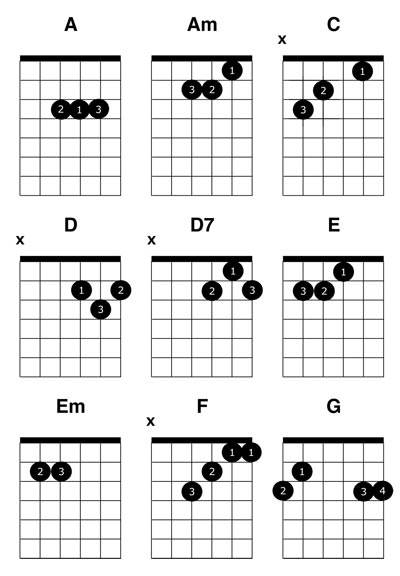Common Guitar Chords
Learn these and you can play thousands of songs
Most modern songs use only a few common guitar chords. In fact, you will find that many use only three... and most use only one or two more. In addition, many of the other chords are simple variations of these.
So, let's get started!
Take a look at the chart of common guitar chords (below). Each chord is identified by its name, such as A, Am, and C.
A chord name by itself, such as A or C, means that it's a major chord.
A lower case 'm' means that it's a minor chord. For example, Em is pronounced E-minor.
The '7' after the name tells you that it's a seventh chord, such as D7, for D-seventh.
Don't worry about the technical difference between major, minor, and seventh chords right now... You'll learn about those as you study music theory on the Music Theory pages (see the sidebar on the left side of this page). Right now... your objective is to learn a few common guitar chords so you can play songs!
How To Read The Chord Chart
The black dots show where to place your fingers. The number inside each dot is a recommended finger. The fingers of your left hand (for right-handed players) are numbered from 1 to 4, starting with your index finger. The thumb is not numbered. You may find some pages that refer to the thumb as 'T'.
The black bar at the top of each grid represents the nut of the guitar, at the top of the neck. Each horizontal line represents a fret. Each vertical line is a string, with the low-E at the left.
A string marked with an 'X' is not played for that chord. Avoid the string as you strum, or deaden it with the finger next to it (or... sometimes the thumb, though some instructors frown on using the thumb for this).
Take a look at the C chord form. Since there is no lower-case letter or number after the C, we know that it's a C-major chord. You form this common guitar chord like this:
- Place your index finger on the first fret of the B string.
- Place your middle finger on the third fret of the D string.
- Place your ring finger on the fourth fret of the A string.
As you strum, do not play the low-E string.
Voila! You can play a C-chord!
Important Tips To Remember!
As you learn these guitar chords, think about these important tips:
- Use only enough pressure to make each string sound good. Do not press too hard.
- Start by slowing strumming each string. If a string sounds odd, adjust your finger position.
- Use only the very tips of your fingers.
- Try changing from one chord to another. Repeat over and over until you can do it smoothly.
- Once you know what each chord sounds like, try to NOT look at your left hand. Learn to recognize the sound of the chord. Learn to place your fingers without looking. You'll want to look, but later, when you need to read music, you'll thank me.
 |


